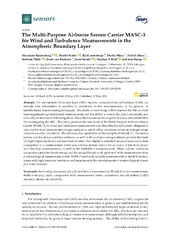| dc.contributor.author | Rautenberg, Alexander | |
| dc.contributor.author | Schön, Martin | |
| dc.contributor.author | zum Berge, Kjell | |
| dc.contributor.author | Mauz, Moritz | |
| dc.contributor.author | Manz, Patrick | |
| dc.contributor.author | Platis, Andreas | |
| dc.contributor.author | van Kesteren, Bram | |
| dc.contributor.author | Suomi, Irene | |
| dc.contributor.author | Kral, Stephan | |
| dc.contributor.author | Bange, Jens | |
| dc.date.accessioned | 2020-05-11T06:03:57Z | |
| dc.date.available | 2020-05-11T06:03:57Z | |
| dc.date.issued | 2019-05-17 | |
| dc.Published | Rautenberg A, Schön, zum Berge, Mauz, Manz, Platis A, van Kesteren, Suomi I, Kral ST, Bange J. The Multi-Purpose Airborne Sensor Carrier MASC-3 for Wind and Turbulence Measurements in the Atmospheric Boundary Layer. Sensors. 2019;19:2292 | eng |
| dc.identifier.issn | 1424-8220 | en_US |
| dc.identifier.uri | https://hdl.handle.net/1956/22163 | |
| dc.description.abstract | For atmospheric boundary-layer (ABL) studies, unmanned aircraft systems (UAS) can provide new information in addition to traditional in-situ measurements, or by ground- or satellite-based remote sensing techniques. The ability of fixed-wing UAS to transect the ABL in short time supplement ground-based measurements and the ability to extent the data horizontally and vertically allows manifold investigations. Thus, the measurements can provide many new possibilities for investigating the ABL. This study presents the new mark of the Multi-Purpose Airborne Sensor Carrier (MASC-3) for wind and turbulence measurements and describes the subsystems designed to improve the wind measurement, to gain endurance and to allow operations under an enlarged range of environmental conditions. The airframe, the capabilities of the autopilot Pixhawk 2.1, the sensor system and the data acquisition software, as well as the post-processing software, provide the basis for flight experiments and are described in detail. Two flights in a stable boundary-layer and a close comparison to a measurement tower and a Sodar system depict the accuracy of the wind speed and direction measurements, as well as the turbulence measurements. Mean values, variances, covariance, turbulent kinetic energy and the integral length scale agree well with measurements from a meteorological measurement tower. MASC-3 performs valuable measurements of stable boundary layers with high temporal resolution and supplements the measurements of meteorological towers and sodar systems. | en_US |
| dc.language.iso | eng | eng |
| dc.publisher | MDPI | en_US |
| dc.rights | Attribution CC BY | eng |
| dc.rights.uri | https://creativecommons.org/licenses/by/4.0/ | eng |
| dc.subject | fixed-wing unmanned aircraft | eng |
| dc.subject | turbulence measurement | eng |
| dc.subject | 3D wind vector measurement | eng |
| dc.subject | stable boundary layer | eng |
| dc.subject | comparison with measurement tower | eng |
| dc.subject | unmanned aircraft system (UAS) | eng |
| dc.subject | remotely piloted aircraft (RPA) | eng |
| dc.title | The Multi-Purpose Airborne Sensor Carrier MASC-3 for Wind and Turbulence Measurements in the Atmospheric Boundary Layer | en_US |
| dc.type | Peer reviewed | |
| dc.type | Journal article | |
| dc.date.updated | 2020-01-10T11:37:11Z | |
| dc.description.version | publishedVersion | en_US |
| dc.rights.holder | Copyright 2019 The Author(s) | en_US |
| dc.identifier.doi | https://doi.org/10.3390/s19102292 | |
| dc.identifier.cristin | 1698506 | |
| dc.source.journal | Sensors | |
| dc.relation.project | Norges forskningsråd: 251042/F20 | |

